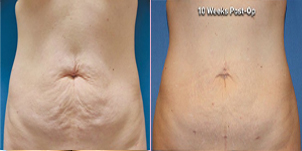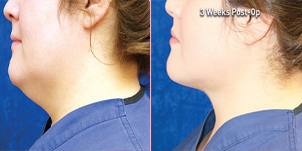Tummy Tuck after Massive Weightloss
Conveniently located to serve the areas of Miami, FL

Reclaim Your Confidence and Shape
Tummy tuck surgery after massive weight is a way for patients who have lost weight, either through bariatric surgery or lifestyle changes, to regain their figure.
Patients who have lost over 50% of their body weight can contour and streamline their figure by addressing loose skin and muscle laxity. [1] There are different types of tummy tuck surgery available, but which one is right for you? Each method targets different areas of the midsection and offers unique benefits and considerations. Whether you want to boost your confidence, eliminate the discomfort associated with hanging skin, or finally feel the pride in your body you’ve worked so hard for, we’ve got you covered.
Patients in beautiful Miami, FL, love showing off their figures after tummy tuck surgery at Miracle Mile Cosmetic Surgery Center. Dr. Gary Vela is a skilled, board-certified plastic surgeon who has the experience required to attain stunning results and make a significant impact on your life. With their expert guidance and personalized approach, you can achieve the desired results and feel confident and comfortable in your skin again. Call for a consultation today! Reach out at (305) 901-2388 or via our online form.
Contents
- 1 About Tummy Tuck after Massive Weightloss
- 2 What are the Benefits of a Tummy Tuck After Massive Weight Loss?
- 3 Who is the Ideal Candidate for Tummy Tuck After Massive Weight Loss?
- 4 Personal Consultation
- 5 Preparation
- 6 The Procedure
- 7 Recovery
- 8 What are the Results of a Tummy Tuck After Massive Weight Loss?
- 9 What is the Cost of Extensive Tummy Tuck in Miami?
- 10 References
About Tummy Tuck after Massive Weightloss
Our skin, the largest of our organs, is incredibly resilient and can adapt to various physical and environmental stresses. For example, it can stretch to accommodate weight gain or pregnancy and heal from minor injuries such as cuts and scrapes. However, there is a limit to the skin’s resilience. When stretched or stressed beyond its natural limits, it can lose its ability to bounce back and return to its original shape.
The underlying elastic and collagen fibers can damage or weaken when the skin is stretched. As a result, the skin may sag, wrinkle, or develop stretch marks. While the skin has some natural regenerative abilities, it can only repair itself to a certain extent.
Once the damage becomes too severe or the skin is stretched beyond its natural limits, it may require surgical intervention to restore its appearance and function. This is where cosmetic procedures like tummy tucks and other types of plastic surgery can be helpful for those looking to improve the appearance of their abdomen after significant weight loss or other physical changes.
Extended Tummy Tuck After Significant Weight Loss
An extended tummy tuck achieves the same goals as a traditional tummy tuck, while also addressing excess skin and tissue on the flanks and lower back. This procedure allows the surgeon to tighten the abdominal muscles and remove the excess skin while improving the overall contour of the trunk. The incision for an extended tummy tuck is longer than a traditional tummy tuck, which typically is made between the hip bones. In an extended tummy tuck, it reaches around the hips to the lower back. However, the scar can be hidden under clothing, and most patients find that the procedure’s benefits outweigh any concerns about scarring.
Circumferential Abdominoplasty After Significant Weight Loss
Circumferential abdominoplasty is also called a belt lipectomy, as it is a more extensive procedure that involves removing an entire “belt” of tissue from the entire circumference of the patient’s torso. Because the incisions extend all the way around the waistline, surgeons can achieve more comprehensive contouring of the entire trunk, as well as lifting and smoothing the area below the waist. This technique is particularly suitable for patients whose weight loss resulted in loose and sagging skin in the torso’s front, back, and sides.
Compared to extended tummy tucks, circumferential abdominoplasty requires a more complex surgical approach, since more tissue is being removed, and many layers of tissue must be carefully sutured. As a result, the surgery and recovery period are typically longer, and patients may experience more discomfort during the healing process. However, the benefits of a circumferential abdominoplasty can be significant, including a more dramatic transformation of the entire torso, improved body shape, and enhanced self-confidence.
Avelar Tummy Tuck
The Avelar tuck is a modification of the traditional tummy tuck. It requires less manipulation of the overlying skin, which allows for more extensive liposuction to be performed safely. It is a popular option for patients who may not have as much muscle damage but are concerned with fat deposits along the flanks as well as the abdomen.
Fleur de Lis Tummy Tuck
The Fleur de Lis tummy tuck uses a vertical incision along with the standard horizontal incision made during an abdominoplasty. The vertical incision is made in the center of the abdomen and extends from the breastbone to the pubic bone. This allows the surgeon to remove a larger amount of excess skin from the upper abdomen so that when the vertical incision is closed, a corseted effect is created. While the Fleur de Lis tummy tuck may be more effective at achieving a dramatic transformation, it does leave a larger scar than the other tummy tuck procedures.
What are the Benefits of a Tummy Tuck After Massive Weight Loss?
Before a tummy tuck to address tissue after massive weight loss, patients may experience discomfort or pain due to excess skin and tissue in the abdominal area. A tummy tuck can address skin irritation where skin folds or overlaps on the abdomen. Removing rolls of excess tissue can provide patients with a wider range of mobility, making it easier to bend over.
Additionally, patients who struggled to find clothing that fit properly or felt self-conscious about their appearance can now enjoy a wider array of wardrobe options that can be worn comfortably, and a boost in confidence!
Once patients heal from surgery, the renewed freedom to move, jump, run, and participate in physical activities without the hindrance of excess skin can greatly improve their mobility and overall physical health. The rectus abdominis muscle is the primary muscle responsible for providing core stability. Weakness or any changes in the muscle can result in increased pressure on the lower back, particularly in obese patients. [3] Improved core strength is a benefit of tummy tuck surgery, and the surgeon will repair and realign the abdominal muscles that may have separated. Patients who undergo body contouring procedures after bariatric surgery have been found to have improved long-term weight control outcomes. [2] Pain relief, improved body confidence, and a boost in self-esteem are also commonly reported benefits of the procedure for patients in Miami, FL.
Who is the Ideal Candidate for Tummy Tuck After Massive Weight Loss?
Before undergoing any of the aforementioned tummy tuck procedures, patients must meet certain criteria to ensure their safety and the success of the surgery. Generally, candidates for a tummy tuck should be in good overall health, both physically and mentally, and have realistic expectations for the outcome of the surgery. Ideal candidates should be non-smokers or willing to quit smoking before and after the surgery. Candidates have significant excess skin and fat in the abdominal area and weakened abdominal muscles. However, they should be stable and have been at their goal weight for at least six months. Additionally, candidates should be committed to maintaining a healthy lifestyle with regular exercise and a balanced diet to ensure the longevity of their results.
Personal Consultation
During the consultation for body contouring surgery, the surgeon will evaluate the patient’s medical history, current health status, and desired outcome. The surgeon will conduct a physical examination to assess the patient’s skin elasticity, fat distribution, and the extent of excess skin. They will also inquire about the patient’s weight loss history, lifestyle habits, and any previous surgeries. Based on this evaluation, the surgeon will recommend the most appropriate body contouring procedure for the patient. The surgeon will explain the details of the recommended procedure, including the risks and benefits, and answer any questions. They will also discuss the expected recovery time and post-operative care instructions. We aim to provide patients with the most effective and personalized treatment plan to help them achieve their body contouring goals. To schedule your consultation, call (305) 901-2388 or reach out online.
Preparation
Preparing for a tummy tuck requires physical and mental preparation. Patients must achieve a stable weight for at least six months to a year before surgery. They should stop smoking and avoid taking certain medications and supplements that can increase the risk of complications during and after surgery.
Patients should be prepared for the recovery process, which can be lengthy. Arrange for someone to help with daily activities during the initial recovery period. The surgeon will provide additional instructions or advice tailored to the patient’s needs and medical history. By following the pre-surgery instructions and being mentally prepared, patients can increase their chances of a healthy and successful recovery.
The Procedure
After checking in for surgery, patients will be made comfortable before the start of their surgery. Traditional, extended, circumferential, Avelar, and Fleur de Lis tummy tucks are performed while the patient is sedated with general anesthesia.
The Traditional Tummy Tuck
Though this technique is generally not suitable for patients who have experienced massive weight loss, all surgeries stem from this method. The surgeon makes an incision across the lower abdomen, usually extending from hip to hip. The skin and fat are then lifted away from the abdominal muscles. The surgeon tightens the abdominal muscles, removes excess skin and fat, and closes the incision.
The Extended Tummy Tuck
This procedure is similar to the traditional tummy tuck but with the addition of an incision that extends around the hips to remove excess skin and fat from the sides of the body.
The Belt Lipectomy
Circumferential abdominoplasty, also known as a belt lipectomy, is a more extensive procedure that addresses excess skin and fat in the abdomen and the lower back, hips, and buttocks. This procedure involves a circular incision around the waistline, allowing the surgeon to lift and tighten the skin and fat around the entire midsection.
The Avelar Tummy Tuck
The Avelar tummy tuck is a modified version of the traditional abdominoplasty incorporating liposuction. The Avelar technique differs from traditional tummy tucks because it preserves the deep fascial layer, which can help maintain the blood supply to the abdominal wall, reducing the risk of complications. [4] The procedure is known for producing excellent cosmetic results.
The Fleur-de-Lis Tummy Tuck
The technique involves an incision made in the vertical direction and the horizontal incision made in the traditional tummy tuck. This results in a scar that looks like an upside-down “t.” The vertical incision allows for more tissue removal in the midline of the abdomen. The Fleur-de-lis tummy tuck can improve the appearance of the abdomen, waist, and hips and provide patients with a more contoured and toned midsection.
Recovery
Patients must wear a compression garment for several weeks following the surgery to help reduce swelling and support healing. Drains will be in place and removed under your surgeon’s care.
It is important to avoid strenuous physical activity or heavy lifting for several weeks after the procedure to prevent complications and ensure proper healing. Patients should plan to take significant time off work or other obligations to allow their bodies to rest and recover.
During the initial stages of recovery, patients must take medications as the surgeon prescribes to manage pain and prevent infection. The surgeon will also provide detailed instructions on caring for the incision site, which will involve keeping it clean and dry. Patients should monitor their incision site for signs of infection or other complications, such as excessive bleeding, fever, or abnormal discharge.
Over time, patients can gradually resume their normal activities as their bodies heal and regain strength. Following the surgeon’s instructions and attending all scheduled follow-up appointments is important to ensure a safe and successful recovery.
What are the Results of a Tummy Tuck After Massive Weight Loss?
After a tummy tuck procedure, Miami patients can expect a flatter, smoother abdominal area. The removal of excess skin and fat can lead to a significant reduction in the overall size of the abdomen, resulting in a more proportionate and balanced figure.
Patients may also notice improved posture and reduced back pain due to removing excess tissue, reducing weight and pressure in the abdominal area. Patients can fit into smaller sizes and feel more comfortable in form-fitting clothes.
The extent of the results will vary depending on the individual’s starting point and the specific procedure performed. It may take several months for the full results to become apparent as the body continues to heal and adjust to the changes.
What is the Cost of Extensive Tummy Tuck in Miami?
In addition to discussing the technical aspects of the surgery, the consultation will cover the financial aspects of the procedure. The surgeon will provide an estimate of the cost of the surgery, which may include facility fees, anesthesia fees, and other related expenses. We offer financing for those who qualify.
Call us at (305) 901-2388 for a consultation appointment today!
References
- Langer V, Singh A, Aly A, Cram A. Body contouring following massive weight loss. Indian Journal of Plastic Surgery. 2011;44(1):14. https://doi.org/10.4103/0970-0358.81439
- Balagué, Nicolas M.D.; Combescure, Christophe M.D.; Huber, Olivier; Pittet-Cuénod, Brigitte M.D.; Modarressi, Ali M.D.. Plastic Surgery Improves Long-Term Weight Control after Bariatric Surgery. Plastic and Reconstructive Surgery 132(4):p 826-833, October 2013. | DOI: 10.1097/PRS.0b013e31829fe531
- Puri J, Sharma S, Samuel AJ, Chahal A. Investigate Correlation between Diastasis of Rectus Abdominis Muscle and Low Back Pain in Obese Women. Journal of Lifestyle Medicine. 2021;11(1):38-42. https://doi.org/10.15280/jlm.2021.11.1.38
- Lopez Q. Two-Year Experience with the Avelar Abdominoplasty. The American Journal of Cosmetic Surgery. 2008;25(2):92-96. https://doi.org/10.1177/074880680802500204



